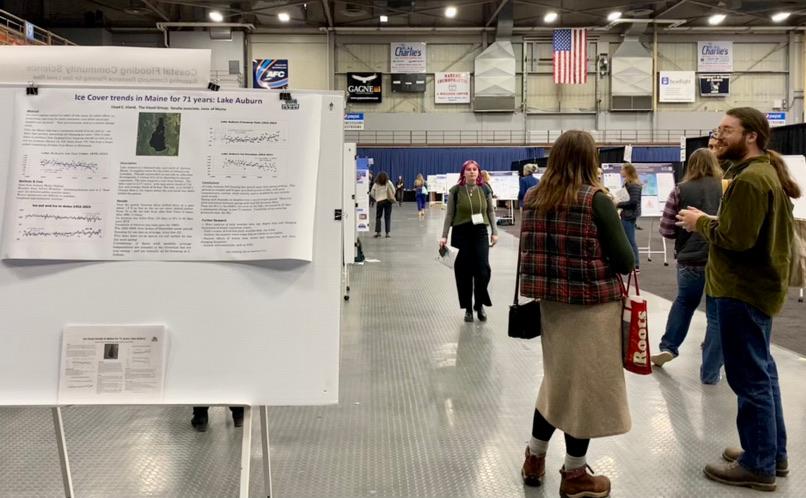Editor’s Note: The following story first appeared in The Maine Monitor’s free environmental newsletter, Climate Monitor, that is delivered to inboxes every Friday morning. Sign up for the free newsletter to get important environmental news by registering at this link.
It’s been a common refrain for years now: the climate migrants — people seeking refuge from heat, droughts, floods and fires — are coming, and they’re going to come to Maine, with its abundance of fresh water and increasingly favorable climate “niche.”
“The pandemic may in fact be a snapshot of what climate migration will look like in the decades to come,” Hans Carlson, executive director for Blue Hill Heritage Trust, told listeners at the 2023 Maine Sustainability & Water Conference in Augusta last week.
More than 34,000 people moved to Maine during the pandemic, said Vanessa Levesque, of the University of Southern Maine, during a presentation at the conference. The vast majority came from elsewhere in the United States, although the Maine also took in nearly 3,500 international migrants, including many fleeing conflicts in Ukraine and countries in Africa.
RELATED: Maine’s population grew in 2022, fueled by new out-of-state residents
The big question now, of course, is whether the pandemic was an anomalous blip or a vision of what’s to come.
“As disasters get worse, as the climate gets more severe, is this going to be a trend where people just keep moving to the nearest metropolitan area?” wondered Rachel Renders, a student at Cornell University who, along with her co-author Lauren Oertel, presented a paper on migration histories and trends in the northeast.
“Or are things going to totally shift and we’ll start seeing people have to relocate because where they were is completely uninhabitable? We don’t know.”

Much of the research around climate migration assumes that people will be forced to move far from where they’re currently living, said Renders, and that there will be a mass wave of people moving north to escape extreme heat and humidity in the south.
“But there have been more and more studies coming out about how far people relocate after a natural disaster, and it’s only like, five to eight miles, on average, from where they currently live.” In 2021, Redfin found that more people were moving in to risky areas than out of them, and polling has found that most Americans would rather rebuild than move if disaster strikes.
This suggests that it might actually be policy, not weather, that eventually spurs mass climate migration. Federal officials have begun to publicly acknowledge that the market distortions created in part by policies that fail to address climate change have created a “moral hazard,” which is economist-speak for policies that incentivize risk-taking.
Think flood insurance. For decades, the federal government has subsidized flood insurance policies, keeping prices artificially low, even though homeowners in flood-prone areas tend to be wealthier than the typical homeowner. The National Flood Insurance Program is at risk of insolvency, and yet people keep building — and buying — homes on the edge of the water.
Local governments are happy to have these property owners on their tax rolls, since they tend bring in more revenue. But when disaster strikes, it’s the federal government that bears most of the cost. Unless officials at all levels exert more pressure on how and where people build homes and businesses, evidence suggests that we will continue to live and rebuild in risky areas.
That said, there are plenty of well-documented cases of people whose moves were prompted, at least in part, by the threat of climate disaster. My co-newsletter writer, Annie Ropeik, profiled several of them a couple of years ago for New Hampshire Public Radio. I’ve met climate migrants in the grocery store, the dog park, in town meetings — displaced Californians fleeing wildfires in the west, North Carolinians escaping rising seas.
RELATED: Fleeing to Maine from climate disasters
One common thread among the current climate migrants is class: it tends to be easier for wealthier people to pick up and move in the face of climate risk than it is for poorer people. That’s likely to increase existing social inequities and put even more stress on an already strained housing market, said Levesque, and other services such as childcare.
But migration is the only way Maine’s population can grow, as our Baby Boomers have aged out of their childbearing years (the youngest Boomers are now 59) and the number of deaths in the state has begun to exceed births. The labor force constraints we’re feeling now — a shortage of engineers, plumbers, teachers, electricians — are only likely to increase as Boomers retire and there are fewer workers to fill their jobs.
And if we’re prepared, said Levesque, newcomers also provide an opportunity — for diversity, for youth, for a more robust workforce, for an improvement in services, for fresh perspectives and innovation.
“Humans have moved around this planet for a very long time. We’ve survived massive demographic shifts, we’ve created thriving economies over and over again,” said Renders. “I think people can get very nervous when we start projecting and predicting all these shifts that are going to happen in the future, but we’ve done this before we can do it again.”
To read the full edition of this newsletter, see Climate Monitor: The climate migrants are coming! … Maybe?.
Kate Cough covers climate change and the environment for The Maine Monitor. Reach her with story ideas by email: gro.r1752117182otino1752117182menia1752117182meht@1752117182etak1752117182.








